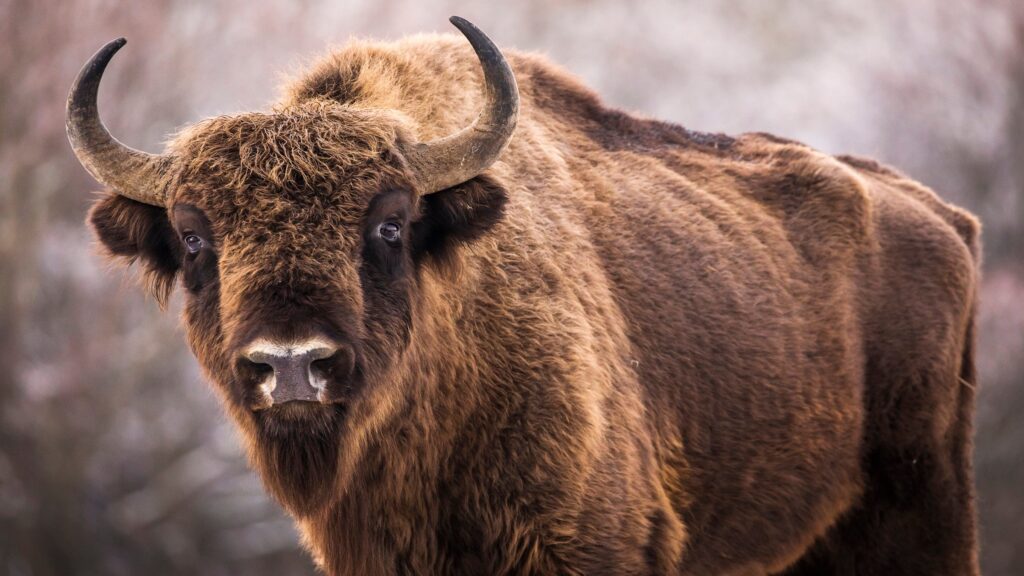Weighing more than 2,000 pounds, one bison will poop enough in a typical day to fill a 3-gallon bucket.
North America was once home to approximately 30 million grazing bison that ranged across the continent. (Photo: danm/Getty Images)
Published August 29, 2025 10:57AM
Bill Hamilton’s chest freezer probably looks a lot different than yours. While most of us pack ours with groceries, Hamilton stores pounds upon pounds of bison dung in his.
Hamilton, a professor of biology and research science at Washington and Lee University in Virginia, studies the role bison and other large herbivores play in ecosystems. In a new study published this month, Hamilton explains how bison, and their poop, are the key to a healthy environment in some parts of the U.S.
“Humans have been applying dung as a fertilizer for millennia, so we know it’s an important fertilizer. Bison are a restoration story, and allowing their grazing in places like Yellowstone provides a ‘reawakening’ of the landscape,” Hamilton told Outside.
According to Hamilton’s study, freely roaming bison in Yellowstone National Park—the only place in the lower 48 where bison have continuously free-ranged since prehistoric times—play a pivotal role in the ecosystem. Bison contribute to a healthier landscape by adding nitrogen to the soil, which supports the growth of nutrient-dense plants. The bison’s impact on the soil, in turn, supports the many animals that call Yellowstone home.
Outside of Yellowstone, most bison are domesticated and kept in confined areas, such as in zoos and conservation parks. The study suggests that environments in the American West and Midwest could be healthier if bison were allowed to roam freely.
The study is the latest wrinkle in a simmering debate over whether bison herd size should be managed, and whether or not bison should be excluded from certain areas due to concerns about overgrazing. Hamilton’s research suggests that the eating habits—and pooping—of large bison populations may actually help the landscape in ways previously not fully understood.
“Animals need to be able to move,” Hamilton told Outside in a phone interview. “Free-roaming bison restore ecological processes across a long-distance migration.

A Keystone Species Returns
North America was once home to approximately 30 million grazing bison that ranged across the continent. By 1889, after being hunted nearly to extinction, that number dropped to under 1,000. In 1902, there were just 23 animals. Recent recovery efforts in areas like Yellowstone National Park have focused on returning the giant ungulates to specifically managed areas.
Bison are to Yellowstone National Park what African wildebeest are to the Serengeti, their influence on the land essential, says Hamilton. And like the wildebeest, bison dung packs a nutritional punch when deposited across the landscape.
In areas with heavy bison grazing, Hamilton found plants were denser, shorter, and more nitrogen-rich. Not only did these plants grow as much as they would have if they weren’t grazed, Hamilton’s team found them to be 150 percent more nutritious than plants growing in areas with no bison.
Weighing more than 2,000 pounds, one bison will poop enough in a typical day to fill a 3-gallon bucket. Annually, each Yellowstone bison will migrate around 1,000 miles, making back-and-forth movements over their route. The animals graze on grasses and other plants as they move, which the research team found helps speed up an area’s nitrogen cycle.
Nitrogen is one of the most essential nutrients found in fertilizers, and it’s also considered to be a fundamental building block of life. As bison graze, they speed up the nitrogen cycle by consuming plants and eventually returning nitrogen to the soil through their feces.
As bison contribute to the broader ecosystem of Yellowstone, Hamilton’s research team suggests these benefits might be seen elsewhere. With its diverse, largely undisturbed ecosystem, Yellowstone National Park serves as a living laboratory, providing researchers with a unique window into how North American landscapes appeared before the influence of western hunting efforts.
“This version is a glimpse of what was lost when bison were nearly wiped out across North America in the late 1800s,” said Hamilton. “When we lost bison, we lost a different way that large grazers moved across and used landscapes.”
According to Hamilton, Yellowstone grasslands are functioning better now with large herds of bison than they were in the animals’ absence.
The Latest Discovery From Yellowstone Living Laboratory
Since its establishment in 1872, Yellowstone National Park has served as a living laboratory for the examination of natural processes. Its preserved ecosystem allows researchers to study unique opportunities in a relatively undisturbed environment, including reintroduced species once on the verge of extinction. These population shifts can cause what’s known as a trophic cascade, an ecological process in which a change in the population of a top predator affects other species lower in the food chain, triggering a chain reaction.
Wolves are one such case. After wolves were exterminated from the Yellowstone region in the 1920s, the elk population more than doubled, causing significant damage to the area’s grasses, shrubs, and trees. Following the reintroduction of wolves in 1995, research suggests that elk populations have declined to a more sustainable level, thereby improving the overall health of the ecosystem.
Similarly, beaver populations dramatically declined in much of the park by the mid-20th century due to trapping. Without beavers in the watersheds, streams and river beds eroded. Upon their return—primarily after the reintroduction of wolves—beavers built dams and ponds, slowing water flow and restoring river ecosystems.
“Yellowstone has been a success story and example for ecosystem restoration, and the return of bison is another step towards bringing it back to what it may have been in the past. When bison are given room to roam, they reawaken the Yellowstone ecosystem,” said Hamilton.
The bison study contributes to a growing body of evidence that population control, whether by humans or through natural processes, is a complex and nuanced task.
For researchers like Hamilton, the next challenge lies in finding suitable locations large enough to reintroduce bison, which can then migrate in large numbers.


